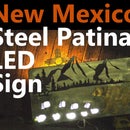Introduction: Chaotic Squares Metal Wall Art
This project was completed for a customer. They had drawn a sketch of a design they liked inspired by something they had seen on vacation. We interpreted that sketch to create this artwork with the only requirement being we hit a width dimension of 80", which we did.
The piece was built from 12ga Hot Rolled Steel, or in English: steel approximately 1/10" thick, made from steel formed while hot (as opposed to cold with a lot more pressure being used to flatten it). Hot rolled steel is more stress-laden and prone to warping slightly, but is about 3/4 the price of cold rolled steel and suited the requirements of this project.
Step 1: Plasma Cutting
We used our shop-built CNC Plasma Table to cut the steel squares out. In total the project required about 2'x4' of steel as the squares nested well together. The ultimate cost of the steel was less than $20. We also used some of the extra space to cut out some letters for another project.
After cutting the pieces with plasma (VERY hot gas that vaporizes the steel) they are left with a slight burr along the edge of the cut. This is made less of a problem by the water you see on the cutting table, but it is easily removed with a wire cup on a grinder. The wire cup spins quickly and simply knocks the dross (technical name for the burr) off the cut edge. Any stubborn portions are removed with a traditional grinding disk.
Step 2: Layout
The idea of the art piece was that each square would interlock with its neighbors. To accomplish this we first laid out the design, then marked where to cut squares so they could be interlaced. We made the cuts on the square that would be the bottom piece in an intersection so it would be hidden. These cuts could be done with the plasma cutter, a grinder, jigsaw, etc, but in our case we used a port-a-band bandsaw as it is easy to use and quick. The marked pieces were then laid out and adjusted to meet the client's vision.
Step 3: Tacking Together
a tack weld is a short, brief weld used to hold pieces of metal in place rather than to permanently attach them. Tacks are strong only in tension and are easily broken by bending or twisting, allowing some forgiveness in assembly. We first tacked all the pieces from the "face" side of the piece where we could hide the tacks in a joint.
Step 4: Welding
We eventually flipped the piece over and welded all the intersections from the rear where the welds would be hidden. Our welding settings were 17.5V, 108A, at ~175 inches per minute of .035" welding wire. This meant we were welding a "colder" weld that would normally be called for, but it was strong enough for our purposes and led to less heat distortion and warping, so was the right choice.
The dark pictures so "arc shots" where you can see what a welder sees while wearing a welding helmet. Those helmets block approximately 99% of all light, allowing you to safely look at a weld in progress, which is brighter than the sun!
Step 5: Grinding
Sometimes a weld needs to be ground down to clean it up.
We first used a flat cut-off disk to get into hard to reach areas (use VERY light pressure when doing so) and then used a flapdisk, which is like a circular stack of sandpaper, to smooth everything out.
Step 6: Stud Welding
Here we used a studwelder to attach short lengths of threaded rod to the back of the piece. The final GIF shows how to do so without purchasing an expensive tool, but we do this enough that the cost was justified.
The studs will eventually be set into holes in the brick wall this mounts to and glued into place for the final assembly.
A stud welder is (simply) a large box of capacitors that discharge quickly through a stud, welding it to the base metal in a fraction of a second. The advantage is in speed, but also in precisions, studs are place perfectly perpendicular to the steel.
Step 7: Powdercoating
We then sent the piece off for powdercoating, which is like painting except that it bakes on a very thin, but durable coat of color plastic that is more consistant and resilient than paint. The process can be done at home too, but we choose to subcontract that work out. Total cost for powdercoating was $40, well worth it in my book!
Step 8: Installation
This project was in a customer's home and I didn't want to take pictures, so I'm using a similar project we did for a local Equestrian center to demonstrate. We first drill holes where needed in the brick wall using an SDS drill.
We located those holes, by using a dot of paint on the end of each stud, then simply pressing the piece into place to transfer that paint to the wall.
We drilled 1/4" holes for the 1/4" studs, then wallored them out a bit to ease in installation.
Next we added some construction adhesive to glue the stud into place and inserted the whole piece at one.
The last step is simple to clean up any glue squeeze out and allow 12 hours for the glue to dry.
Step 9: Complete!
This project was a lot of fun and in this picture hopefully you'll see that the slight angles between pieces catch the light in different ways.
If you'd like to see the whole build video, please check it out:













